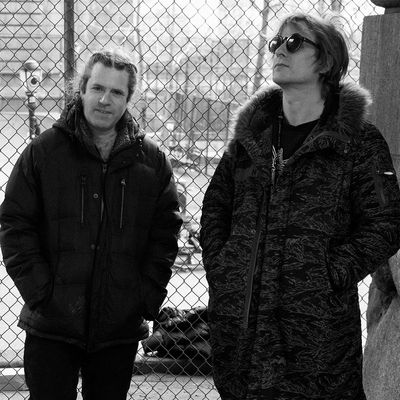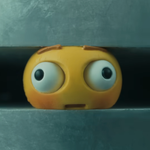
One of the most appealing qualities of New York City experimental band Gang Gang Dance is their magpie-like ability to incorporate a vast spectrum of references and styles. Over the last 15 years they’ve released music that touches on everything from dancehall to J-pop, without succumbing to hoary world-music clichés. Their brand of polychromatic electro-pop hews closer to M.I.A. than, say, Michael Franti. They have a gift for drawing unexpected connections and an endless curiosity for cutting-edge global rhythms.
Over the course of the ’00s, Gang Gang Dance played a fascinating role in New York City’s cultural ecosystem. They came from a punk and harsh noise background, having grown up around bands like Fugazi in Washington, D.C. When they came to New York, though, they found themselves also serving as a bridge between the gnarly underground music scene and the rarefied art world. They palled around with conceptual darlings like Dan Colen, the late Dash Snow, and Harmony Korine (with whom founding member Brian DeGraw released a deeply weird EP in 1999). In 2008, the band’s mixed-media work was even included in the Whitney Biennial. They weren’t making stuffy music for galleries, though. Gang Gang Dance were creating alongside the era’s nascent blog culture, when artists began smashing together sounds from around the world to see what might stick. The band released five albums over the course of the decade, culminating in their 2011 full-length Eye Contact on 4AD.
Then they took a break. DeGraw retreated from New York City, where he’d lived since the ’90s, and moved to a house on top of a mountain in Woodstock, New York. Over the next seven years, the band — currently comprised of DeGraw, singer Lizzi Bougatsos, and guitarist Josh Diamond —worked on and off on Kazuashita, its sixth record, which finally came out on June 28. Where their past releases typically packed in a sprawling abundance of sound, their latest has a dreamier quality. As DeGraw explains, the calm new direction reflects the meditative lifestyle he enjoyed during his long break from New York City’s clamor. Still, they haven’t lost either their kaleidoscopic sound palette or their political edge: on the standout track “Young Boy (Marika in Amerika),” Bougatsos mourns victims of police brutality over hypnotic Middle Eastern percussion and trance-y synths. The tempo may be a touch slower than on their early work, but Gang Gang Dance haven’t diluted their vision.
Below, DeGraw reflects on the creative inspirations that have guided him and his bandmates as they recorded the album over the last few years, including Rita Ackermann, Terrence Malick, and, uh, vegetarian burgers.
The Cure
“Something I revisited from my youth is that I was listening to a lot of live, Disintegration-era Cure. There’s a sense of calm when they perform that really resonated with me. Normally when we’re onstage, I don’t consider us a calm presence; particularly for me performing, I have so many tasks and there’s a lot of thinking. I’m not able to relax and take in the music as it’s happening. Watching that footage, it made me want to make music in a way where it would be easier for me while playing live to be immersed in the feeling of it, rather than the technicalities.
The second song on the record, ‘J-TREE,’ was directly influenced by the first song on Disintegration, ‘Plainsong.’ It’s expansive and and trance-like in a way we don’t normally do. We’re usually a bit more spazzy and rushed. In a lot of the new songs, there’s the dynamic of going from something more spacious and trance-y and then exploding into a grander version of that, instead of being caught up in mathematics and too many moving parts, and different sounds.”
Spoken Word
“As far as the more spoken-word aspect of this record, that was very directly influenced by David Bowie’s song ‘Future Legend,’ the opener of Diamond Dogs. That was a very big influence on our spoken-word piece ’( novae terrae ).’ Another one is ‘Imperfect List,’ a song by a project called Big Hard Excellent Fish, from the U.K. in the ’90s. I believe it was made by an acid house producer, but the music is a very tense, chill-inducing kind of ambient music, that basically just lists off terrible things in the world. It’s incredibly emotional.
Having a spoken-word section helps glue the whole thing together. The record is meant to be appreciated as one piece of music; it’s not really constructed in terms of songs. I like to use [spoken word] as transitional pieces that glue together the pieces before and after, and help turn it into one longer piece of music.”
Meditation
“The biggest influence for me on this record outside of music was honestly meditation, more than reading or watching films. That whole span of three or four years of my life preceding the record was all about silence. Before our last record, around 2010, I started splitting my time between New York City and upstate New York, and I started realizing that between touring so much and coming back to a city that’s so hectic and loud and dirty and expensive and chaotic, I was losing my mind a little bit. I started having physical reactions to the city and I had this urgent feeling that I needed to reconnect with nature. Eventually I bailed on the city completely in 2012, and I moved to Woodstock to the top of a mountain, this really amazing house that I randomly found. Every morning I would look out and I would literally be looking down on the tops of clouds. That launched me into this period of five years of just being really content with that, not needing much else in my life. It wasn’t a struggle, I wasn’t trying to exorcise demons or anything, it was just the pure joy of being around nature again. I started meditating every day, and then my whole life became a meditation. I was focusing on experiencing simple pleasures and not much else.”
Earthship architecture
“Most of the things I read [over the past few years] were functional. I read books on how to build sustainable structures, and books on gardening and things like that. It does bleed into the record, but it’s not in this direct art-reference type of way. But the things I was studying definitely affected me. I was studying Earthship architecture. Earthships are the most self-sustainable, off-grid type of housing that exists. The way they’re constructed architecturally, they just exist off the angles of the sun, and they can produce their own food indoors. They were created by this guy Michael Reynolds, who was this mad architect — he was a conventional architect but then he started wanting to escape from society. He started researching how to construct a living space that didn’t require any money to maintain. The foundations and the walls are made from discarded materials, tires and tin cans. My goal is to have a piece of land and start building all sorts of things like that, where we can have an art studio and living space. So I was physically meditating on all these ideas — the intention of those buildings is so pure and gentle and innocent. So anything you do when you’re learning and reading about them, it infuses you with that spirit. Even if you’re just reading about what could be considered very dull building techniques and technicalities and logistics, for me, even doing that acts as a self-help exercise, because it’s coming from such a good place. There’s no evil involved in any of that. Most things have a whole lot of evil involved. I was completely swimming in all these things that were detached from evil, it was this drifting meditative feeling, and ever since then, that’s been a goal in creating anything for me, to remember how great that felt. When I was living in the city, I liked embracing the chaos, I like embracing all the schizo energy and the madness. Now I’m trying to channel all that chaos through this filter that I’m talking about, of serenity and peacefulness.”
Terrence Malick
“For everyone in the band, Malick has always been a favorite filmmaker. The mood of those films, and the approach, and the way sound is used in relation to picture. I remember thinking a lot about a couple specific Malick moments while making the record. While we were sequencing, I started remembering that opening sequence of Tree of Life, about the creation of Earth. In an ideal situation I would make a record that sounded exactly like that. That’s the goal. He’s such a master. I also love the way that as he gets older, he strips away the shit that’s unnecessary to him. He’s making ambient films, they’re so non-narrative and nonlinear, they’re just these floaty moods. It’s amazing. The most recent one I saw is To the Wonder, where he strips away everything that holds a film together. It’s just vignettes.”
Rita Ackermann
“We were actually going to use one of her paintings as the cover, but it didn’t work out in the end. She makes these chalkboard paintings that look like line drawings that have been erased on a chalkboard. The paintings have a similar sense, at least to me, as our record: They have a foggy, misty feeling. The idea of erasing something that’s been drawn is an idea we’ve been incorporating more and more. A lot of these pieces of music were much more dense to start with — making this record was about erasure, about stripping away. The last song, ‘Salve on the Sorrow,’ was initially really full-on. If you listen to that whole song, there’s a crescendo at the end; the whole song was like that crescendo before, from beginning to end, but it became about completely throwing away so many aspects of it until it was just a floor tom and the vocals. A lot of other instances on the record were also about taking things away.”
Michael Powell
“There’s a quick sample from the Michael Powell film Age of Consent on ‘Salve on the Sorrow.’ It’s about this painter basically living on an island by himself. The character is a famous painter who just wants to get away in the middle of nowhere by himself with his dog and make paintings. That’s all the film is about, him living on this island with his dog trying to paint pictures. That sample is just when he cracks a beer. It’s really simple. Just alone on an island, sounds like a great life. I can really relate to the desire for that.”
Roy De Forest
“Another painter is this artist Roy De Forest, who I didn’t know anything about until this past year. I discovered him when we were finishing up the record. He’s amazing, he’s a Bay Area guy from the ’70s and ’80s. I saw a group of his drawings in a show when we were sequencing the record — they were very naïve, figurative things. It was a really interesting use of contrasting textures. He used very clean, childlike line drawings, but then there would be this weird quality of soft pastels. Everything has dogs, which is interesting ’cause there’s that Age of Consent sample that also has the dog — I’m discovering things as we speak — and there are these drawings on paper that have little spots of soft pastel. I was thinking of those things when I was mixing and sequencing, and trying to achieve some of those contrasting textures. I think of music very visually to begin with, so those things always affect me. Everything is about color and texture, line quality or pattern. It’s a synesthetic relationship. That song “Salve on the Sorrow,” at the beginning it’s so stripped down, and there’s moments when you’ll hear something that appears just once through the song, like a cloudy reverb-y effect that trails one of Liz’s vocals. When I do things like that musically, it’s very much an example of me trying to replicate musically something like a little spot of pastel on the drawing. When there’s harp parts on that song, if I hadn’t been thinking in that visual way, that harp wouldn’t be there.”
Superiority Burger
“Cooking does something similar: I think a lot about the way textures and flavors in food interact with each other, especially when I’m mixing. Sometimes when you add a crunchy aspect that you wouldn’t normally think of, it completely elevates the entire meal. Our friend Brooks [Headley] has this restaurant called Superiority Burger, and it’s incredible. Every time I eat there, one of those surprising elements just elevates the entire thing, I would definitely say that Superiority Burger influenced the record. His salads and his soups, to me, have the same quality as the Roy De Forest drawings. There’s some kind of coconut potato baked soup that he makes, it’s really simple, but it has that magic pastel, that line, the food equivalent. A potato coconut base, a little cilantro, some kind of oil, but then he bakes potato skins and puts them on top, like a crouton or whatever. It’s shit like that where I’m like, “Oh my God, he took it to a whole ’nother level.” He does weird things with adding pretzels to salads, and all kinds of “low-end foods,” but he turns them into delicious high-end cuisine, and it’s all extremely affordable. It’s these touches that for me are not inspiring me from a musical place, they are coming from these outside elements, of seeing or tasting, or touching. The films we talked about are influential, but the truth is that for me the films that actually influenced the record the most are cooking shows. I learn a lot more about music through watching any random cooking show, the way the elements go together, than analyzing songs. That, to me, is musical knowledge.”




